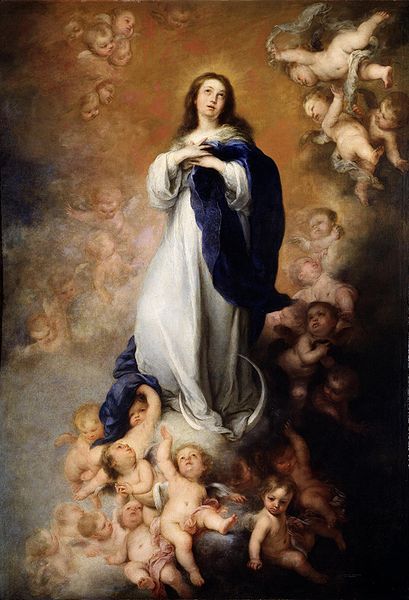Bartolomé Esteban Murillo
Bartolomé Esteban Murillo (Seville, Spain, ca. 1617 - Seville, Spain, 1682) was a Spanish Baroque religious painter. To learn painting, he copied works by artists including Peter Paul Rubens and Antony van Dyck. Murillo mainly devoted himself to religious subjects; the Virgin theme alone was represented about twenty times by Murillo. He is one of the most famous painter of the Spanish Golden Age along with El Greco, Diego Velazquez, Francisco de Zurbarán and José de Ribera. Murillo had an important influence in America's Spanish colonies painting. Among his chief patrons were the religious orders, especially the Franciscans, and the confraternities in Sevilla (Seville) and Andalusia.[1]
Murillo was one of the most famous artists in all of Europe, far more famous even than Velázquez. Murillo's paintings were considered the triumph of the Spanish Baroque. He is best known as the painter of sweetness and light.[2]
In the 1650s a striking transformation of style occurred, usually attributed to a visit to Madrid, where Murillo undoubtedly met Velázquez and studied the works of Titian, Rubens, and Van Dyck in the royal collections. The softly modeled forms, rich colours, and broad brushwork replaced his early realism and tenebrism (contrasting light and shade). Ibidem
The Paul Getty Museum describes how "the market for Bartolomé Estebán Murillo's pictures was so large and lucrative that the king (of Spain) refused to allow their export from the country. In 1660 Murillo founded and served as president of the Seville Academy. Today, in Spain a good painting is called a Murillo." [3]
Contents
Gallery
La Asunción de la Virgen (1670), The Hermitage, St. Petersburg.
Assumption of the Virgin, ca. 1678, Museo del Prado.
See also
- Painting Masterpieces
- Painting Schools
- Francisco de Zurbarán
- Golden Age of Spanish Painting
- Mexican Painting
External links
- Murillo at Artcyclopedia
- 7 works by Bartolome Esteban Murillo Fine Arts Museums of San Francisco.
- La Inmaculada y el arte In Spanish.












